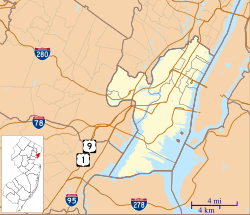First Reformed Dutch Church of Bergen Neck | |
 | |
| Location | Avenue C and 33rd Street, Bayonne, New Jersey |
|---|---|
| Coordinates | 40°40′25″N74°6′52″W / 40.67361°N 74.11444°W |
| Area | 0.3 acres (0.12 ha) |
| Built | 1866 |
| Architectural style | Italianate, Italianate vernacular |
| NRHP reference No. | 82003274 [1] |
| NJRHP No. | 1449 [2] |
| Significant dates | |
| Added to NRHP | April 22, 1982 |
| Designated NJRHP | October 23, 1981 |
The First Reformed Dutch Church of Bergen Neck, now known as The First Federated Church of Bayonne is located in Bayonne, Hudson County, New Jersey, United States. The church was added to the National Register of Historic Places on April 22, 1982. [3]
Contents




